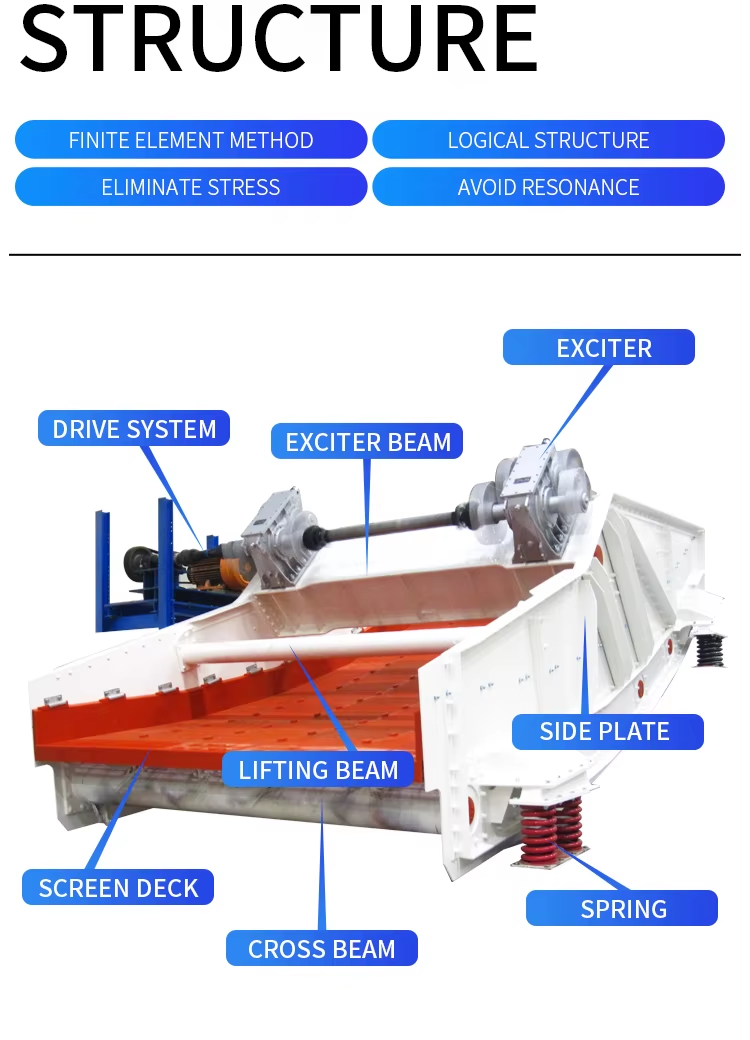What is the efficiency of a vibrating screen?
- Vibrating screening definition
A vibrating screen, also known as a vibratory sieve or vibratory separator, is a device used to separate particles by size through the application of vibration. It consists of a screen mesh or surface which vibrates in order to separate particles based on their size or shape. Vibrating screens are commonly used in industries such as mining, construction, agriculture, and recycling to efficiently sort and classify materials.
2.Working principle of Vibrating screening
A vibrating screen operates on the principle of applying vibration to the screening surface in order to separate particles based on size. This is achieved by imparting a series of rapid vibrations to the screen mesh or surface, causing the particles to move and separate according to their size or shape. The vibration is typically generated by an electric motor with an eccentric weight attached to it, which creates a circular motion. As the material is fed onto the vibrating screen, smaller particles pass through the openings in the screen mesh while larger particles are retained on the surface. This process allows for efficient sorting and classification of materials according to their particle size, making vibrating screens widely used in various industries for screening and sorting applications.

3.Product introduction
Functions: grading, desludging, and desliming (slit screen plates can also be used for dehydration).Screen plate selection: steel structure screen plate and full polyurethane screen plate.Vibrator selection: ZDQ series vibrator.Feeding particle size: 0-300mm, suitable for classifying large and medium-sized coal and non-coal materials with high fine particle content.
Function: grading, deintermediation, desludge.Screen plate selection: steel structure screen plate and full polyurethane screen plate.Vibrator selection: ZDQ series vibrator.Feeding particle size: 0-300mm, suitable for classifying large and medium-sized coal and non-coal materials with high fine particle content.
Function:Grading.Screen plate selection: punching screen plate, rod screen plate, woven screen plate.Vibrator selection: RDQ series vibrator.Feeding particle size: 0-300mm, suitable for primary and secondary classification of conventional materials.
- Linear screen, banana screen
Function: screening sticky materials.Screen plate selection: fixed screen surface (woven, punched, rods, slits) and relaxation screen plate.Vibrator selection: ZDQ series vibrator or RDQ series vibrator Feeding particle size: 0-50mm.When the fixed sieve plate is used for relaxation screening, the feed particle size is 0-300mm.
- Rod screen (rod feeder)
Function: feeding + pre-screening.Screen plate selection: Steel structure rod screen plate (manganese steel, stainless steel, wear-resistant material).Vibrator selection: ZDQ series vibrator .feeding particle size: 30-1000mm suitable for pre-screening of large-grained materials
Designed for dewateringpurposes. The screen plate features polyurethane frame with stainless steel strip seams or full polyurethane strip seams. The vibrator selection includes ZDQ series vibrators or vibrating motors. It is suitable for a feed particle size of 0-5mm and is used for dewatering froth coal and coal slurry in coal mines, as well as dewatering fine sand in non-coal applications.
Available in vibrating and non-vibrating variants, both designed for dewatering purposes. The vibrating variants come equipped with vibrating motors, while the non-vibrating variants do not include motors. The screen plate features curved screen plates. Vibrator selection includes vibrating motors. It is suitable for a feed particle size of 0-5mm and is used for dewatering froth coal and coal slurry during transportation in coal mines, as well as dewatering fine sand in non-coal applications.
4.Vibrating screening Power and Efficiency
The power consumption of a screening machine is typically measured in kilowatts (kW) and is determined by factors such as the size and type of the vibrating motor or vibrator used, the size of the screen surface, and the amplitude and frequency of vibration. Higher power ratings are generally associated with larger and more heavy-duty screening machines capable of handling larger feed rates or tougher materials.
The efficiency of a screening machine refers to its ability to effectively separate and classify materials while minimizing energy consumption and maximizing throughput. Several factors influence the efficiency of a screening machine, including the design and configuration of the screen surface, the type and quality of screen panels or mesh, the amplitude and frequency of vibration, and the angle of inclination of the screen surface. A well-designed and properly maintained screening machine will have high efficiency, resulting in accurate particle separation, minimal material carryover, and reduced downtime.
In summary, the power and efficiency of a screening machine are closely related to its design, components, and operational parameters, and they play crucial roles in determining the overall performance and effectiveness of the screening process in various industrial applications.


